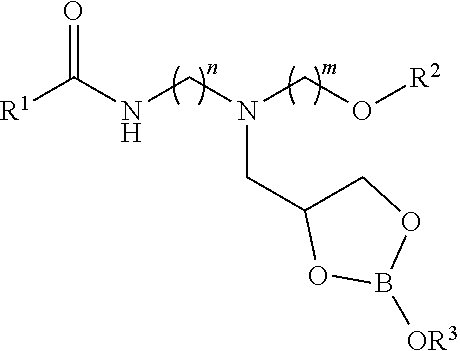Less corrosive organoboron compounds as lubricant additives
a technology of organoboron compounds and additives, which is applied in the direction of additives, lubricant compositions, organic chemistry, etc., can solve the problems of reducing the performance of glycerol monooleate, and oxidation and hydrolysis of traditional organic friction modifiers, so as to reduce the severity of observed copper and lead corrosion, meet or exceed antioxidant, frictional and/or wear performance, and reduce the severity of observed lead
- Summary
- Abstract
- Description
- Claims
- Application Information
AI Technical Summary
Benefits of technology
Problems solved by technology
Method used
Image
Examples
Embodiment Construction
[0011]In the first step, a carbonyl-containing compound such as a carboxylic acid, carboxylic acid ester, or triglyceride is reacted with a mixed primary / secondary amine-containing compound to form a secondary amide. In the second step, the secondary amide intermediate is reacted further with glycidol to furnish a 2,3-dihydroxypropyl adduct. The second step can be performed in the presence of a protic solvent such as methanol or ethanol to improve the reaction efficiency. In the third step, the glycidol adduct is reacted with a boron source such as boric acid in the presence of water. The reaction mixture containing the boron complex can be diluted with process oil resulting in the final organoboron product.
[0012]As highlighted above, the class of compounds in this invention may also be described as the reaction products of an organic ligand and a boron source performed in the presence of water. The organoboron-containing product can be diluted with process oil. The relative ratios ...
PUM
| Property | Measurement | Unit |
|---|---|---|
| corrosive | aaaaa | aaaaa |
| friction | aaaaa | aaaaa |
| hydrolytic stability | aaaaa | aaaaa |
Abstract
Description
Claims
Application Information
 Login to View More
Login to View More - R&D
- Intellectual Property
- Life Sciences
- Materials
- Tech Scout
- Unparalleled Data Quality
- Higher Quality Content
- 60% Fewer Hallucinations
Browse by: Latest US Patents, China's latest patents, Technical Efficacy Thesaurus, Application Domain, Technology Topic, Popular Technical Reports.
© 2025 PatSnap. All rights reserved.Legal|Privacy policy|Modern Slavery Act Transparency Statement|Sitemap|About US| Contact US: help@patsnap.com



